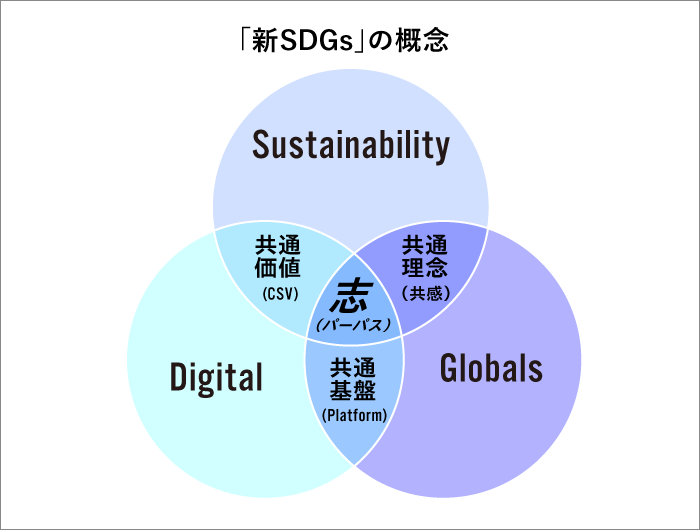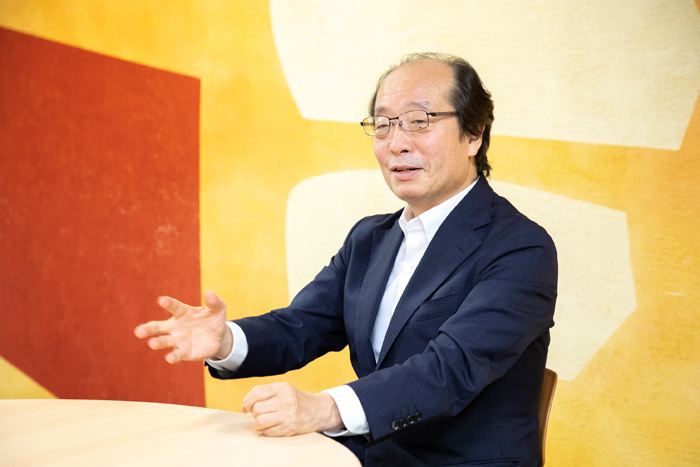Creating Next-Generation 100-Year Companies: What Are the "New SDGs" and "Vision-Driven Management"?
Professor Takashi Nawa is a management professional who was among the first to recognize the importance of environmental business and CSV management, actively promoting their adoption by companies. After careers at Mitsubishi Corporation and McKinsey & Company, he became a Visiting Professor at Hitotsubashi University Business School, where he teaches while serving as an outside director for numerous companies.
What exactly does Professor Nawa envision as "surviving companies" and "sustainable companies"? What are the "new SDGs" and "aspiration-based management" needed for the coming era...? He shared his perspectives on SDGs and innovation from the viewpoint of corporations and business.

Inspired by the new concept of "CSV Management" proposed by this leading authority on competitive strategy
──Professor Nawa, you have published numerous books and research on CSV (Creating Shared Value) management. First, could you tell us about your encounter with CSV management?
Nawa: CSV management is a concept proposed in 2011 by Professor Michael Porter of Harvard Business School (HBS). Professor Porter was my mentor during my time at HBS. He was originally renowned as a leading authority on competitive strategy. For years, he had consistently discussed business through the lens of values like "stepping on others to get ahead" and "winning the competition is everything." Then suddenly, he shifted his perspective and declared, "Isn't the true goal for companies to achieve both solving societal problems and economic activity?" This was a profoundly shocking event.
The CSV management concept instantly broadened the perspective outward, breaking free from the narrow, squabbling economic theories confined to a small world. It felt like a breakthrough, or a shift to a new layer. I distinctly remember thinking, "That's Professor Porter for you."
Encountering Professor Porter's CSV paper became a major trigger for me. Since then, I've focused on introducing and promoting CSV management, became conscious of the SDGs, and have continued on this path to the present.
──You are currently advocating for the concept of "New SDGs," aren't you? What exactly are these New SDGs that Professor Nawa proposed?
Nawa: SDGs stands for "Sustainable Development Goals," an international framework outlining 17 targets to achieve by 2030. The "New SDGs," on the other hand, are more like an equation for companies to find the direction they should aim for, looking ahead to 2050. The S remains largely the same as in the standard SDGs, standing for "Sustainability." However, the D is replaced with "Digital," and the G with "Globals." Crucially, the most vital element in the "New SDGs" is the "Purpose" that connects these three components. I believe that going forward, management must be centered around this "Purpose" – pursuing the founding vision and the fundamental question of "Why should our company tackle this challenge?"

From SDGs to New SDGs. And from capitalism to purpose-driven capitalism. To survive long-term and become truly sustainable companies, we must change now.
What is required of companies going forward is "Purpose-Driven Management" and "Multi-Perspective Thinking."
──What exactly is the "aspiration" in aspiration-based management?
Nawa: In a word, it is the "North Star" for the company. This North Star represents the company's origin, its universal stance, and its ultimate vision—the guiding beacon toward which it strives. With this clearly visible, there is no room for confusion, and strategies and actions remain unwavering.
To discover this North Star, an ultra-long-term perspective is indispensable. I feel Japanese companies are overly fond of mid-term management plans, constantly setting goals for three or five years ahead. Yet in such a complex, rapidly changing world, predictions for three or five years simply cannot be accurate. If they were, it would mean the company isn't growing. Therefore, it's crucial to look 30 or 50 years into the future and consider universal, correct trends.
Take the automotive industry, for example. Gasoline will inevitably run out someday. No one knows exactly when, and there are many debates, but it will happen. For instance, recognizing the trend from an ultra-long-term perspective – thinking, "Since oil will run out, we must develop cars powered by alternative energy" – and envisioning the ultimate vision is the first step toward approaching that North Star.
Additionally, focusing on "excitement, uniqueness, and capability" to uncover a company's origins, values, and individuality is vital. When starting a company or joining one, many people take that first step with great ambition, excitement, and a vision of unique business ventures or societal contributions specific to their company. Hidden within that passion is often an ultimate "aspiration" that transcends mere profit or loss. It's also crucial to examine past crises and unravel how the company overcame them. What was thought through and preserved during tough times, or the path chosen, often represents the company's most vital ideas or products. This is how we discover that unique, valuable North Star specific to the company.
──Once the North Star is found, what comes next? Earlier, you mentioned that "mid-term management plans aren't necessary." Does that mean we should only focus on long-term goals?
Nawa: No, that approach simply wouldn't suffice. Once the North Star is clear, we then work backward from it to develop ultra-short-term strategies—daily or weekly plans. As seen in this pandemic, societal conditions change moment by moment. Without the adaptability to closely monitor daily situations and adjust accordingly, we simply cannot compete.
Ultra-long-term and ultra-short-term. Combining these perspectives, we use "multi-focal thinking" to repeatedly zoom in and zoom out. This journey, I believe, is what transforms a company into a sustainable one.

Innovation is what connects solving social issues with economic activity!
──As an example of finding a North Star and sparking innovation, could you share a memorable project you were involved in, Professor Nawa?
Nawa: There are many... but I found the Mitsubishi Chemical Holdings Group's initiative truly remarkable. They began CSV-like efforts even before Professor Porter announced CSV management. First, they involved nearly 1,000 employees in workshops, redefining purpose and guiding stars at each operational site. Through 50 workshops, they developed a future-oriented brand statement. They then established three pillars to support this statement: "Sustainability," "Innovation," and "Economic Activity," and are now promoting these company-wide.
Notably, "Innovation" is included among these three pillars. Professor Porter's proposed CSV management theory focused on "balancing the resolution of social issues with economic activity," and did not explicitly include innovation. However, this company recognized early on that "innovation is necessary to balance solving social issues with economic activity" and clearly incorporated it.
This refined vision and the three pillars have permeated the company, leading to groundbreaking new products like plant-based biodegradable resins that contribute to the sustainability of both the planet and the company. Furthermore, recognizing that "human health is indispensable for the sustainable growth of society and business," the company has also been continuously realizing innovations in work practices.
The key points of the "New SDGs" lie in D (Digital) and G (Global)
──Digital and technological power are indispensable for driving innovation, aren't they? The new SDGs you propose, Professor Nawa, also include "digital." How do you perceive the power of digital?
Nawa: I believe it is a highly effective driving force for innovation. However, it's not ideal when it's used in a siloed manner, confined to individual fields like agritech or foodtech. Simply applying tech to agriculture and food separately makes it difficult to generate truly innovative new value, and it doesn't hold much significance. Connecting agriculture and food with other sectors like finance, healthcare, and education—that's what leads to true innovation and DX.
That's where the "aspiration" I mentioned at the beginning becomes essential. The stronger the conviction – "This is what we want to achieve," "This is our mission" – the more organically diverse data will connect. Digital is ultimately just a tool. Rather than tech-specific knowledge or skills, I believe it's analog beliefs like passion and willpower that truly enhance digital value.
──What does the "G" (Global) in the new SDGs signify?
Nawa: To manage a company with an eye on the future 30 or 50 years ahead, a global perspective is indispensable. Awareness of issues and sensitivity are sharpened not just domestically, but by connecting with more organizations and people overseas. I strongly encourage looking not only at Europe and America, but also at Asia's SDGs and CSV management.
For example, India has a law requiring companies to allocate 2% of their profits to social contributions. This system has spurred growth in venture companies tackling social businesses and fostered collaboration with large corporations. In Bangladesh, Grameen Bank provides loans to the poor. Beyond lending, it supports borrowers in achieving self-sufficient livelihoods, generating profits that are reinvested—a business model that could be called a "new capitalism."
Elsewhere, in China, where Confucius's concept of "Yili Heyi" (the integration of righteousness and profit) is deeply rooted, the idea that "businesses must pursue righteousness, not just profit" is gaining traction in the economic sphere. Jack Ma, the founder and former CEO of Alibaba, began strongly advocating this, and it quickly spread, particularly among young people. Now, many companies are following suit.
Emerging nations face mountains of social challenges, so I believe there are many valuable hints for considering CSV management going forward.
Before CSV management, during the era when CSR (Corporate Social Responsibility) management was popular, many companies engaged in social contribution activities more as an act of atonement for mass production and consumption, or as a gesture for stakeholders. CSV management, on the other hand, is an initiative directly linked to management: "solving social issues to increase corporate value." With the SDGs, its expansion and penetration are certain. It's never too late to start now. We sincerely hope many companies and their leaders will take this seriously.

TeamSDGs collaborates with various SDG stakeholders to disseminate information about the SDGs and plan/develop solutions.
※ Please also see Professor Takashi Nawa's article here:
How to Foster Innovation: Lessons from McKinsey ~ Professor Takashi Nawa, Visiting Professor, International Corporate Strategy Program, Hitotsubashi University Business School
Was this article helpful?